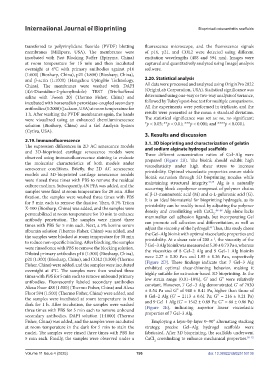Page 204 - v11i4
P. 204
International Journal of Bioprinting Bioprinted osteoarthritis scaffolds
transferred to polyvinylidene fluoride (PVDF) blotting fluorescence microscope, and the fluorescence signals
membranes (Millipore, USA). The membranes were of p16, p21, and COL2 were detected using different
incubated with Fast Blocking Buffer (Epizyme, China) excitation wavelengths (488 and 594 nm). Images were
at room temperature for 15 min and then incubated captured and quantitatively analyzed using ImageJ analysis
overnight at 4°C with primary antibodies against p16 software.
(1:600) (Biosharp, China), p21 (1:800) (Biosharp, China),
and β-actin (1:1000) (Hangzhou UpingBio Technology, 2.20. Statistical analysis
China). The membranes were washed with DAPI All data were processed and analyzed using OriginPro 2022
(4’,6-Diamidino-2-phenylindole) TBST (Tris-buffered (OriginLab Corporation, USA). Statistical significance was
saline with Tween 20) (Thermo Fisher, China) and determined using one-way or two-way analysis of variance,
incubated with horseradish peroxidase-coupled secondary followed by Tukey’s post-hoc test for multiple comparisons.
antibodies (1:2000) (Jackson, USA) at room temperature for All the experiments were performed in triplicate, and the
1 h. After washing the PVDF membranes again, the bands results were presented as the mean ± standard deviation.
were visualized using an enhanced chemiluminescence The statistical significance was set as: ns, no significant;
solution (Biosharp, China) and a Gel Analysis System *p < 0.05; **p < 0.01; ***p < 0.001; and ****p < 0.0001.
(Cytiva, USA).
3. Results and discussion
2.19. Immunofluorescence 3.1. 3D bioprinting and characterization of gelatin
The expression differences in 2D AC senescence models and sodium alginate hydrogel scaffolds
and 3D-bioprinted cartilage senescence models were Three different concentration ratios of Gel–Alg were
observed using immunofluorescence staining to evaluate prepared (Figure 2B). The bioink should exhibit high
the molecular characteristics of both models under viscoelasticity under high shear stress to increase
senescence conditions. Briefly, the 2D AC senescence printability. Optimal viscoelastic properties ensure stable
models and 3D-bioprinted cartilage senescence models bioink extrusion through 3D bioprinting nozzles while
were rinsed three times with PBS to remove the residual maintaining structural integrity. 44,45 Alg is a naturally
culture medium. Subsequently, 4% PFA was added, and the occurring block copolymer composed of polymer chains
samples were fixed at room temperature for 20 min. After of β-D-mannuronic acid (M) and α-L-guluronic acid (G).
fixation, the samples were washed three times with PBS It is an ideal biomaterial for bioprinting hydrogels, as its
for 5 min each to remove the fixative. Then, 0.1% Triton printability can be readily tuned by adjusting the polymer
X-100 (Biosharp, China) was added, and the samples were density and crosslinking with CaCl . 46–48 Alg alone lacks
permeabilized at room temperature for 10 min to enhance mammalian cell adhesion ligands, but incorporating Gel
2
antibody penetration. The samples were rinsed three can promote cell adhesion and differentiation, as well as
times with PBS for 5 min each. Next, a 5% bovine serum adjust the viscosity of the hydrogel. Thus, this study chose
49
albumin solution (Thermo Fisher, China) was added, and the Gel–Alg bioink with optimal viscoelastic properties and
the samples were blocked at room temperature for 30 min printability. At a shear rate of 200 s , the viscosity of the
−1
to reduce non-specific binding. After blocking, the samples 7 Gel–3 Alg bioink was measured at 5.30 ± 0.73 Pa·s, whereas
were rinsed once with PBS to remove the blocking solution. the viscosities of 8 Gel–2 Alg and 9 Gel–1 Alg bioinks
Diluted primary antibodies p16 (1:300) (Biosharp, China), were 2.27 ± 0.30 Pa·s and 1.95 ± 0.36 Pa·s, respectively
p21 (1:300) (Biosharp, China), and COL2 (1:300) (Thermo (Figure 2D). These findings indicate that 7 Gel–3 Alg
Fisher, China) were added, and the samples were incubated
overnight at 4°C. The samples were then washed three exhibited optimal shear-thinning behavior, making it
times with PBS for 5 min each to remove unbound primary highly suitable for extrusion-based 3D bioprinting. In the
antibodies. Fluorescently labeled secondary antibodies low strain range (0.01–10%), G’ and G” were relatively
Alexa Fluor 488 (1:500) (Thermo Fisher, China) and Alexa constant. However, 7 Gel–3 Alg demonstrated G’ of 7830
Fluor 594 (1:500) (Thermo Fisher, China) were added, and ± 8.54 Pa and G” of 948 ± 0.41 Pa, higher than those of
the samples were incubated at room temperature in the 8 Gel–2 Alg (G’ = 2113 ± 0.61 Pa; G” = 216 ± 0.21 Pa)
dark for 1 h. After incubation, the samples were washed and 9 Gel–1 Alg (G’ = 1542 ± 0.89 Pa; G” = 66 ± 0.86 Pa)
three times with PBS for 5 min each to remove unbound (Figure 2E), indicating superior linear viscoelastic
secondary antibodies. DAPI solution (1:1000) (Thermo properties of 7 Gel–3 Alg.
Fisher, China) was added, and the samples were incubated Employing a layer-by-layer 0–90° alternating stacking
at room temperature in the dark for 5 min to stain the strategy, precise Gel–Alg hydrogel scaffolds were
nuclei. The samples were rinsed three times with PBS for fabricated. After 3D bioprinting, the scaffolds underwent
5 min each. Finally, the samples were observed under a CaCl crosslinking to enhance mechanical properties. 50–52
2
Volume 11 Issue 4 (2025) 196 doi: 10.36922/IJB025150136

